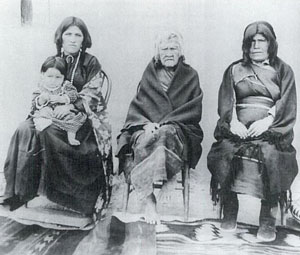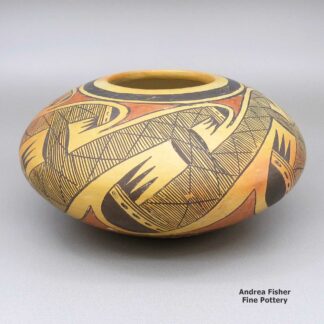Nampeyo, Rachel Namingha

“My mom was a really good artist. She also made really nice dresses for us. She created many of her own designs without looking at anything. She would just sit down and design. I admired her. She had a lot of patience.” – Dextra Quotskuyva speaking of her mother in 1998
Rachel Namingha Nampeyo was the daughter of Annie and Will Healing, granddaughter of Nampeyo of Hano and Lesou. Among Ruth’s children were Dextra Quotskuyva, Priscilla Namingha Nampeyo, Ruth Namingha, Eleanor Lucas Namingha, Emerson Namingha Jr. and Lillian Gonzales.
Rachel was born in 1900 and was active in the marketplace from about 1920 until she passed on in 1985. For much of Rachel’s childhood, her parents were occupied with working the family ranch and she was required to attend classes at the Polacca Day School. That left Rachel often in the care of her grandmother and that’s where she was most exposed to the making of pottery. Soon enough she was transferred to the Phoenix Indian School where the system set about trying to remove all trace of her heritage from her. At the same time, she was taught domestic skills that served her and her family well when her own family started to grow. Years later, other headmasters of the Phoenix Indian School lamented about how the years Nampeyo’s descendants (and other Hopi and Hopi-Tewa children) spent in that school might have been better for most if they had been left at home with their parents, learning the ancient arts and crafts the only way they really can be learned.
Rachel was one of the children who accompanied her parents and Nampeyo to the Grand Canyon to demonstrate pottery-making for several months in 1905. As a teenager she worked as a cook at Hubbell’s Ganado Trading Post, along with Sadie Adams, Laura Lomakema and her aunt, Fannie Nampeyo. One day the three conspired together and pulled a prank on Rachel: they locked her in a closet alone for a while. Rachel was so frightened by the experience she left and walked home to First Mesa.
Around 1923 Rachel married Emerson Namingha. Twelve years later they had seven children in the house and her education in domestic skills was paying off.
Rachel mostly made black-and-red-on-yellow jars and bowls, miniature bowls, effigy bowls with maiden head handles and wind chimes. She was a conservative traditional potter all her life and she tried to impress that on her daughters, too, often chiding them when their designs varied too much from those of the ancients.
In her later years Annie suffered from increasingly poor health and, like her mother, began losing her eyesight. She suffered badly from arthritis and increasingly severe coughing spells. Rachel most often took care of her in those years and was paid with pairs of cotton stockings.
The photo: Four generations of the family. Annie on the left with Rachel in her lap, White Corn in the middle, Nampeyo on the right. Photo was taken outside the Corn clan house in Hano by Adam Vroman in 1903, public domain now.
Showing the single result
-

Rachel Namingha Nampeyo, zzho2m508, Polychrome bowl with a migration pattern geometric design
$925.00 Add to cart
Showing the single result